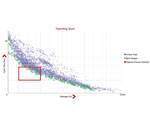Autonomous Optimization Proves Its Worth in LSR Molding
Sigmasoft Autonomous Optimization automatically ran and analyzed 60 simulations to find the best way to mold a challenging LSR part.
A tricky LSR injection molding demonstration at the Fakuma 2018 show in Germany in October was made possible by a new type of simulation technology that automatically performs multiple iterations to home in on a desired outcome. Introduced at the previous year’s Fakuma bySigma Enginering, Sigmasoft Autonomous Optimization is similar to an automated design of experiments (DOE), except that it seeks an optimized result based on the programmer’s instructions (see June feature for details).
At Fakuma 2018, operated a molding cell producing an LSR pot holder with a challenging honeycomb design. Its largest dimension is 210 mm and overall thickness varies from about 3 to 7.5 mm. But the honeycomb walls are only 1 mm thick, and the 83-g shot has a max. flow length of 135 mm from two gates. According to Momentive, this project would have been “very difficult to realize without simulation.” This type of product had never been injection molded before—only compression molded. “We didn’t know what exact injection pressure or clamp force would be required,” says Momentive’s Oliver Franssen, senior global marketing leader for transportation. It was essential to determine in the shortest possible time whether the part could be molded on a machine small enough to fit in the company’s booth. “Also, we wanted to avoid two costly mistakes—air entrapment, and excessive temperature difference across the cavity.”
Sigma ran a total of 60 different simulations, involving three different filling times and 20 different gate positions, over about two days using Sigmasoft Autonomous Optimization. The software also evaluated all the results to identify the best solution. The software determined optimal placement of two gates and, in a second optimization, the position, length, and temperature of electric heaters in the mold. The result was a 55-sec cycle time with no flash, no short shot or air entrapment, and reduction of temperature differences in the cavity from 40° C initially to no more than 10°.
Based on the results of the virtual analysis, the mold was built by in Germany. The extremely compact tool needed no cold-runner block for sprueless molding; instead, the cold-runner head (from of Austria) was attached directly to the 90-ton SmartPower injection machine from Wittmann Battenfeld.
Related Content
-
Using Data to Pinpoint Cosmetic Defect Causes in Injection Molded Parts
Taking a step back and identifying the root cause of a cosmetic flaw can help molders focus on what corrective actions need to be taken.
-
Got Streaks or Black Specs? Here’s How to Find and Fix Them
Determining the source of streaking or contamination in your molded parts is a critical step in perfecting your purging procedures ultimately saving you time and money.
-
Back to Basics on Mold Venting (Part 1)
Here’s what you need to know to improve the quality of your parts and to protect your molds.


